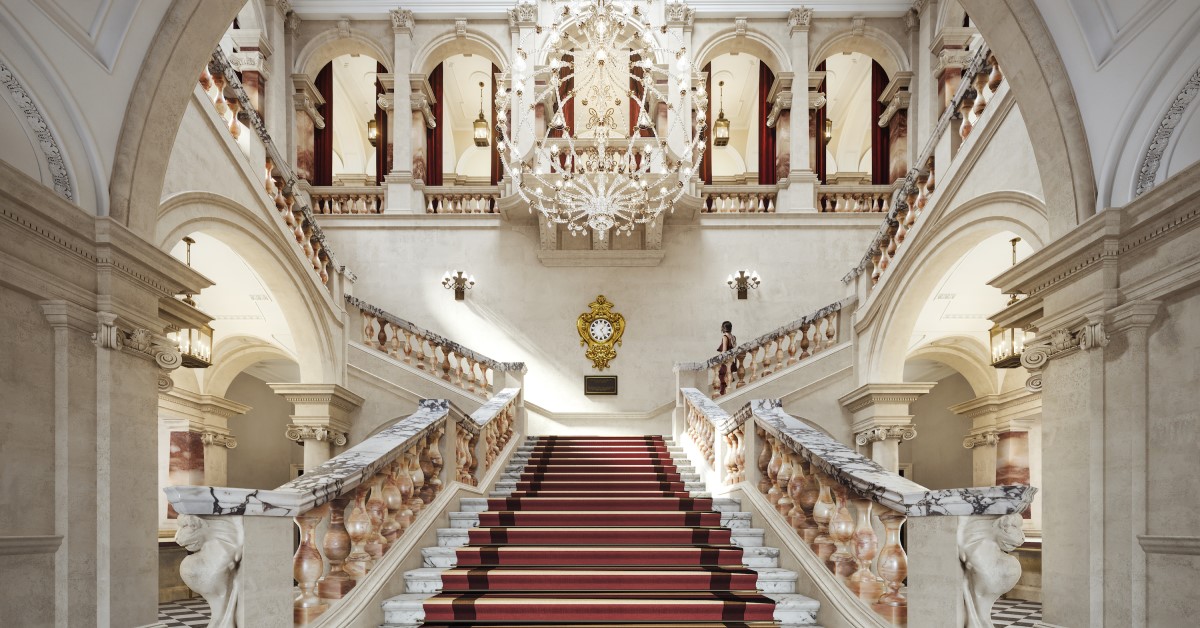With world class luxury developments overlooking Hyde Park and a hotly-anticipated art museum launching this summer, Marble Arch is evolving as a commercial and cultural hub in the heart of Westminster
Words: Will Moffitt
Constructed on the south side of Hyde Park from May 1 until October 15 The Great Exhibition of 1851 was quite the show. Coordinated by civil servant and inventor Sir Henry Cole and Prince Albert, the grounds of one of London’s great parks became a canvas on which to portray Britain’s self-styled image as a place of steam power and success; a world leader in industrialisation and manufacturing capable of building a hulking Crystal Palace three times the size of St Paul’s Cathedral.
Enclosed in this cast iron and plate glass structure were over 100,000 exhibits from around the world, divided broadly into raw materials, machinery, manufactures and the fine arts, drawing in six million visitors including Charles Darwin, Karl Marx, Alfred Tennyson and
Queen Victoria, who is said to have dropped by at least 34 times. Excitable crowds made their way through a then novel Marble Arch to access the festivities, which was transposed from Buckingham Palace and reconstructed by architect Thomas Cubitt in its current location of Cumberland Gate in just three months.
The grand old Arch, of course, has shaped the place around it. More than just a tickbox tourist attraction and a tube line moniker, it carries a suggestion of transience that has come to define the area’s standing in contemporary times.
With the buzz of Oxford Street a short stroll away, along with some of London’s most iconic museums and galleries, Marble Arch has often felt like a gateway to pass through and access exciting things.
More recently, however, it has become a standout location in its own right, buoyed by investment in workspaces and hospitality ventures, along with innovative cultural attractions like Frameless, the immersive digitised art space, that captured minds and blew up social media feeds.

If its previous locations in Amsterdam and Barcelona are anything to go by, Moco Museum looks set to become another cultural magnet. Launching later this summer in a three storey property opposite Hyde Park, Moco’s previous European counterparts draw in 1.5 million visitors annually, a feat its founders are no doubt looking to replicate if not supplant with their London flagship.
“We are committed to showcasing all aspects of contemporary culture and artists that cross over into fashion, music, design and beyond,” say founders Kim and Lionel Logchies. “We want Moco Museum’s London opening to be a new cultural destination for visitors near and far, that is open and welcoming to all despite how much or little they know about art.”
Nascent artists such as the Argentinian digital pioneers Pilar Zeta, Andres Reisinger, and Ezequiel Pini will be platformed in the gallery spaces as well as genre-defining icons like Andy Warhol and Yayoi Kusama. There will also be a temporary exhibition programme and a new retail store and cafe.
Speaking of Moco's first venture outside the continent Kay Buxton, chief executive of Marble Arch London BID, the business improvement district, is eagerly anticipating its launch. “This is a huge vote of confidence in London and the West End, bolstering Marble Arch’s standing as a cultural and leisure hub,” says Buxton, who talks of the area as a “vibrant commercial hub” thanks to its strong provision of workspaces alongside hospitality and retail options.
“Since establishing the BID in 2016, we have seen significant investment into Marble Arch,” Buxton says, “including leading mixed-use schemes such as Marble Arch Place and One Marble Arch, alongside the arrival of new restaurants and hotels.”

A pipeline of “stunning new developments” including One Great Cumberland Place and The Bryanston scheme have played their part too, along with the recent approval of a new food hall at 529-533 Oxford Street, which Buxton describes as “a shot in the arm for Oxford Street [that] has generated huge excitement from our BID members”.
A collection of 54 residences situated at the top of Park Lane, The Bryanston, delivers spacious, quirkily-designed apartments and unrivalled views of Hyde Park and the capital’s iconic skyline. Developed by renowned property and investment group Almacantar – known for their ambitious, large-scale projects across London – and sold through Mayfair estate agency Wetherell the place is divided into two main elements: the podium, with its gracefully tiered terraces and the tower, all 18 storeys-worth of luxury and stretching vistas.
Prioritising space and quality over quantity the apartments have three-metre-high ceilings, gigantic windows and floor space spanning over 200 square metres in more than half the residences. This makes them uniquely expansive – tweaks to planning policy by Westminster City Council will restrict the height and size of future dwellings in this area.
Invariably there’s all of the five-amenities you’d expect from a project of this calibre: 25-metre pool, indoor gym and spa facilities, but it’s in the design where the Bryanston really comes into its own. Unlike many residences of a similar ilk the apartments are eclectic rather than homogenised and uniform. On the 11th floor an apartment designed by David Collins Studio and Nick Vinson is unashamedly loud, splashed in citrine yellows and barbie pinks. Its neighbouring abode is all soft palettes, natural marble and rustic timber.
Those engaging design principles have been elevated by the late Rafael Viñoly, the Uruguayan-born starchitect who rose to prominence with ambitious global commissions like the Tokyo International Forum and London’s “Walkie-Talkie” skyscraper. Viñoly had a passion for a kind of experiential architecture that fed off local environments. At The Bryanston he has stayed true to his legacy: giving residents curved spaces, oversized windows and jaw dropping panoramas. With the pastoral richness of the park on one side and city views on the other, it is a spectacular spot.
For Kathrin Hersel, executive director of Almacantar, the goal behind the development is as lofty and far reaching as its sky soaring vistas. “Our aim was to redefine luxury for residents and exceed all expectations, from delivering world-class amenities to ensuring the best quality of air,” Hersel says. “We have worked with the world’s top talent to go above and beyond, to create the best the world has seen, deeply rooted in this unique location.”
Standing high up on the 11th floor watching the world go by, my expectations are certainly exceeded.









